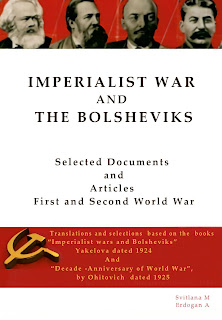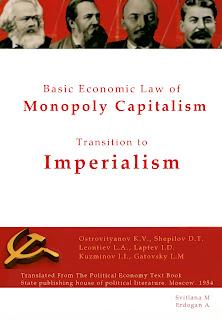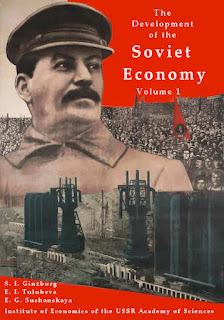ABOLITION OF SERFDOM AND THE DEVELOPMENT OF INDUSTRIAL CAPITALISM IN RUSSIA - 1883 -1901
1. ABOLITION OF SERFDOM AND THE DEVELOPMENT OF INDUSTRIAL
CAPITALISM IN RUSSIA. RISE OF THE MODERN INDUSTRIAL PROLETARIAT.
FIRST STEPS OF THE WORKING-CLASS MOVEMENT
Tsarist Russia entered the path of capitalist development later than other countries. Prior to the sixties of the past century there were very few mills and factories in Russia. Manorial estates based on serfdom constituted the prevailing form of economy. There could be no real development of industry under serfdom. The involuntary labour of the serfs in agriculture was of low productivity. The whole course of economic development made the abolition of serfdom imperative. In 1861, the tsarist government, weakened by defeat in the Crimean War, and frightened by the peasant revolts against the landlords, was compelled to abolish serfdom.
But even after serfdom had been abolished the landlords continued to oppress the peasants. In the process of "emancipation" they robbed the peasants by inclosing, cutting off, considerable portions of the land previously used by the peasants. These cut-off portions of land were called by the peasants otrezki (cuts). The peasants were compelled to pay about 2,000,000,000 rubles to the landlords as the redemption price for their "emancipation."
After serfdom had been abolished the peasants were obliged to rent land from the landlords on most onerous terms. In addition to paying money rent, the peasants were often compelled by the landlord to cultivate without remuneration a definite portion of his land with their own implements and horses. This was called otrabotki or barshchina (labour rent, corvee). In most cases the peasants were obliged to pay the landlords rent in kind in the amount of one-half of their harvests. This was known as ispolu (half and half system).
Thus the situation remained almost the same as it had been under serfdom, the only difference being that the peasant was now personally free, could not be bought and sold like a chattel.
The landlords bled the backward peasant farms white by various methods of extortion (rent, fines). Owing to the oppression of the landlords the bulk of the peasantry were unable to improve their farms. Hence the extreme backwardness of agriculture in pre-revolutionary Russia, which led to frequent crop failures and famines.
The survivals of serfdom, crushing taxation and the redemption payments to the landlords, which not infrequently exceeded the income of the peasant household, ruined the peasants, reduced them to pauperism and forced them to quit their villages in search of a livelihood. They went to work in the mills and factories. This was a source of cheap labour power for the manufacturers.
Over the workers and peasants stood a veritable army of sheriffs, deputy sheriffs, gendarmes, constables, rural police, who protected the tsar, the capitalists and the landlords from the toiling and exploited people. Corporal punishment existed right up to 1903. Although serfdom had been abolished the peasants were flogged for the slightest offence and for the non-payment of taxes. Workers were manhandled by the police and the Cossacks, especially during strikes, when the workers downed tools because their lives had been made intolerable by the manufacturers. Under the tsars the workers and peasants had no political rights whatever. The tsarist autocracy was the worst enemy of the people.
Tsarist Russia was a prison of nations. The numerous non-Russian nationalities were entirely devoid of rights and were subjected to constant insult and humiliation of every kind. The tsarist government taught the Russian population to look down upon the native peoples of the national regions as an inferior race, officially referred to them as inorodtsi (aliens), and fostered contempt and hatred of them. The tsarist government deliberately fanned national discord, instigated one nation against another, engineered Jewish pogroms and, in Transcaucasia, incited Tatars and Armenians to massacre each other.
Nearly all, if not all, government posts in the national regions were held by Russian officials. All business in government institutions and in the courts was conducted in the Russian language. It was forbidden to publish newspapers and books in the languages of the non-Russian nationalities or to teach in the schools in the native tongue. The tsarist government strove to extinguish every spark of national culture and pursued a policy of forcible "Russification." Tsardom was a hangman and torturer of the non-Russian peoples.
After the abolition of serfdom, the development of industrial capitalism in Russia proceeded at a fairly rapid pace in spite of the fact that it was still hampered by survivals of serfdom. During the twenty-five years, 1865-90, the number of workers employed in large mills and factories and on the railways increased from 706,000 to 1,433,000, or more than doubled.
Large-scale capitalist industry in Russia began to develop even more rapidly in the nineties. By the end of that decade the number of workers employed in the large mills and factories, in the mining industry and on the railways amounted in the fifty European provinces of Russia alone to 2,207,000, and in the whole of Russia to 2,792,000 persons.
This was a modern industrial proletariat, radically different from the workers employed in the factories of the period of serfdom and from the workers in small, handicraft and other kinds of industry, both because of the spirit of solidarity prevailing among the workers in big capitalist enterprises and because of their militant revolutionary qualities.
The industrial boom of the nineties was chiefly due to intensive railroad construction. During the course of the decade (1890-1900) over 21,000 versts of new railway line were laid. The railways created a big demand for metal (for rails, locomotives and cars), and also for increasing quantities of fuel—coal and oil. This led to the development of the metal and fuel industries.
In pre-revolutionary Russia, as in all capitalist countries, periods of industrial boom alternated with industrial crises, stagnation, which severely affected the working class and condemned hundreds of thousands of workers to unemployment and poverty.
Although the development of capitalism in Russia proceeded fairly rapidly after the abolition of serfdom, nevertheless, in economic development Russia lagged considerably behind other capitalist countries. The vast majority of the population was still engaged in agriculture. In his celebrated work, The Development of Capitalism in Russia Lenin cited significant figures from the general census of the population of i897 which showed that about five-sixths of the total population were engaged in agriculture, and only one-sixth in large and small industry, trade, on the railways and waterways, in building work, lumbering, and so on.
This shows that although capitalism was developing in Russia, she was still an agrarian, economically backward country, a petty-bourgeois country, that is, a country in which low-productive individual peasant farming based on small ownership still predominated.
Capitalism was developing not only in the towns but also in the countryside. The peasantry, the most numerous class in pre-revolu-tionary Russia, was undergoing a process of disintegration, of cleavage. From among the more well-to-do peasants there was emerging an upper layer of kulaks, the rural bourgeoisie, while on the other hand many peasants were being ruined, and the number of poor peasants, rural proletarians and semi-proletarians, was on the increase. As to the middle peasants, their number decreased from year to year.
In 1903 there were about ten million peasant households in Russia. In his pamphlet entitled To the Village Poor, Lenin calculated that of this total not less than three and a half million households consisted of peasants possessing no horses. These were the poorest peasants who usually sowed only a small part of their land, leased the rest to the kulaks, and themselves left to seek other sources of livelihood. The position of these peasants came nearest to that of the proletariat. Lenin called them rural proletarians or semi-proletarians.
On the other hand, one and a half million rich, kulak households (out of a total of ten million peasant households) concentrated in their hands half the total sown area of the peasants. This peasant bourgeoisie was growing rich by grinding down the poor and middle peasantry and profiting from the toil of agricultural labourers, and was developing into rural capitalists.
The working class of Russia began to awaken already in the seventies, and especially in the eighties, and started a struggle against the capitalists. Exceedingly hard was the lot of the workers in tsarist Russia. In the eighties the working day in the mills and factories was not less than 12½ hours, and in the textile industry reached 14 to 15 hours. The exploitation of female and child labour was widely resorted to. Children worked the same hours as adults, but, like the women, received a much smaller wage. Wages were inordinately low. The majority of the workers were paid seven or eight rubles per month. The most highly paid workers in the metal works and foundries received no more than 35 rubles per month. There were no regulations for the protection of labour, with the result that workers were maimed and killed in large numbers. Workers were not insured, and all medical services had to be paid for. Housing conditions were appalling. In the factory-owned barracks, workers were crowded as many as 10 or 12 to a small "cell." In paying wages, the manufacturers often cheated the workers, compelled them to make their purchases in the factory-owned shops at exorbitant prices, and mulcted them by means of fines.
The workers began to take a common stand and present joint demands to the factory workers for the improvement of their intolerable conditions. They would down tools and go on strike. The earlier strikes in the seventies and eighties were usually provoked by excessive fines, cheating and swindling of the workers over wages, and reductions in the rates of pay.
In the earlier strikes, the workers, driven to despair, would sometimes smash machinery, break factory windows and wreck factory-owned shops and factory offices.
The more advanced workers began to realize that if they were to be successful in their struggle against the capitalists, they needed organization. Workers' unions began to arise.
In 1875 the South Russian Workers' Union was formed in Odessa. This first workers' organization lasted eight or nine months and was then smashed by the tsarist government.
In 1878 the Northern Union of Russian Workers was formed in St. Petersburg, headed by Khalturin, a carpenter, and Obnorsky, a fitter. The program of the Union stated that its aims and objects were similar to those of the Social-Democratic labour parties of the West. The ultimate aim of the Union was to bring about a Socialist revolution—"the overthrow of the existing political and economic system, as an extremely unjust system." Obnorsky, one of the founders of the Union, had lived abroad for some time and had there acquainted himself with the activities of the Marxist Social-Democratic parties and of the First International, which was directed by Marx. This circumstance left its impress on the program of the Northern Union of Russian Workers. The immediate aim of the Union was to win political liberty and political rights for the people (freedom of speech, press, assembly, etc.). The immediate demands also included a reduction of the working day.
The membership of the Union reached 200, and it had about as many sympathizers. It began to take part in workers' strikes, to lead them. The tsarist government smashed this workers' Union too.
But the working-class movement continued to grow, spreading from district to district. The eighties were marked by a large number of strikes. In the space of five years (1881-86) there were as many as 48 strikes involving 80,000 workers.
An exceptional part in the history of the revolutionary movement was played by the big strike that broke out at the Morozov mill in Orekhovo-Zuyevo in i885.
About 8,000 workers were employed at this mill. Working conditions grew worse from day to day: there were five wage cuts between 1882 and 1884, and in the latter year rates were reduced by 25 per cent at one blow. In addition, Morozov, the manufacturer, tormented the workers with fines. It was revealed at the trial which followed the strike that of every ruble earned by the workers, from 30 to 50 kopeks went into the pocket of the manufacturer in the form of fines. The workers could not stand this robbery any longer and in January 1885 went out on strike. The strike had been organized beforehand. It was led by a politically advanced worker, Pyotr Moiseyenko, who had been a member of the Northern Union of Russian Workers and already had some revolutionary experience. On the eve of the strike Moiseyenko and others of the more class-conscious weavers drew up a number of demands for presentation to the mill owners; they were endorsed at a secret meeting of the workers. The chief demand was the abolition of the rapacious fines.
This strike was suppressed by armed force. Over 600 workers were arrested and scores of them committed for trial.
Similar strikes broke out in the mills of Ivanovo-Voznesensk in 1885.
In the following year the tsarist government was compelled by its fear of the growth of the working-class movement to promulgate a law on fines which provided that the proceeds from fines were not to go into the pockets of the manufacturers but were to be used for the needs of the workers themselves.
The Morozov and other strikes taught the workers that a great deal could be gained by organized struggle. The working-class movement began to produce capable leaders and organizers who staunchly championed the interests of the working class.
At the same time, on the basis of the growth of the working-class movement and under the influence of the working-class movement of Western Europe, the first Marxist organizations began to arise in Russia.
2. Narodism (Populism) and Marxism in Russia. Plekhanov and His “Emancipation of Labour” Group. Plekhanov’s Fight Against Narodism. Spread of Marxism in Russia
2. Narodism (Populism) and Marxism in Russia. Plekhanov and His “Emancipation of Labour” Group. Plekhanov’s Fight Against Narodism. Spread of Marxism in Russia


























.jpg)

















